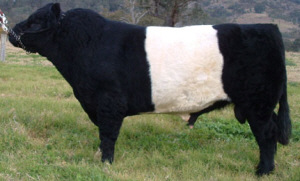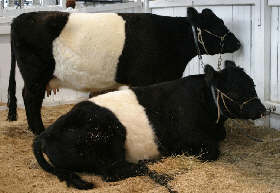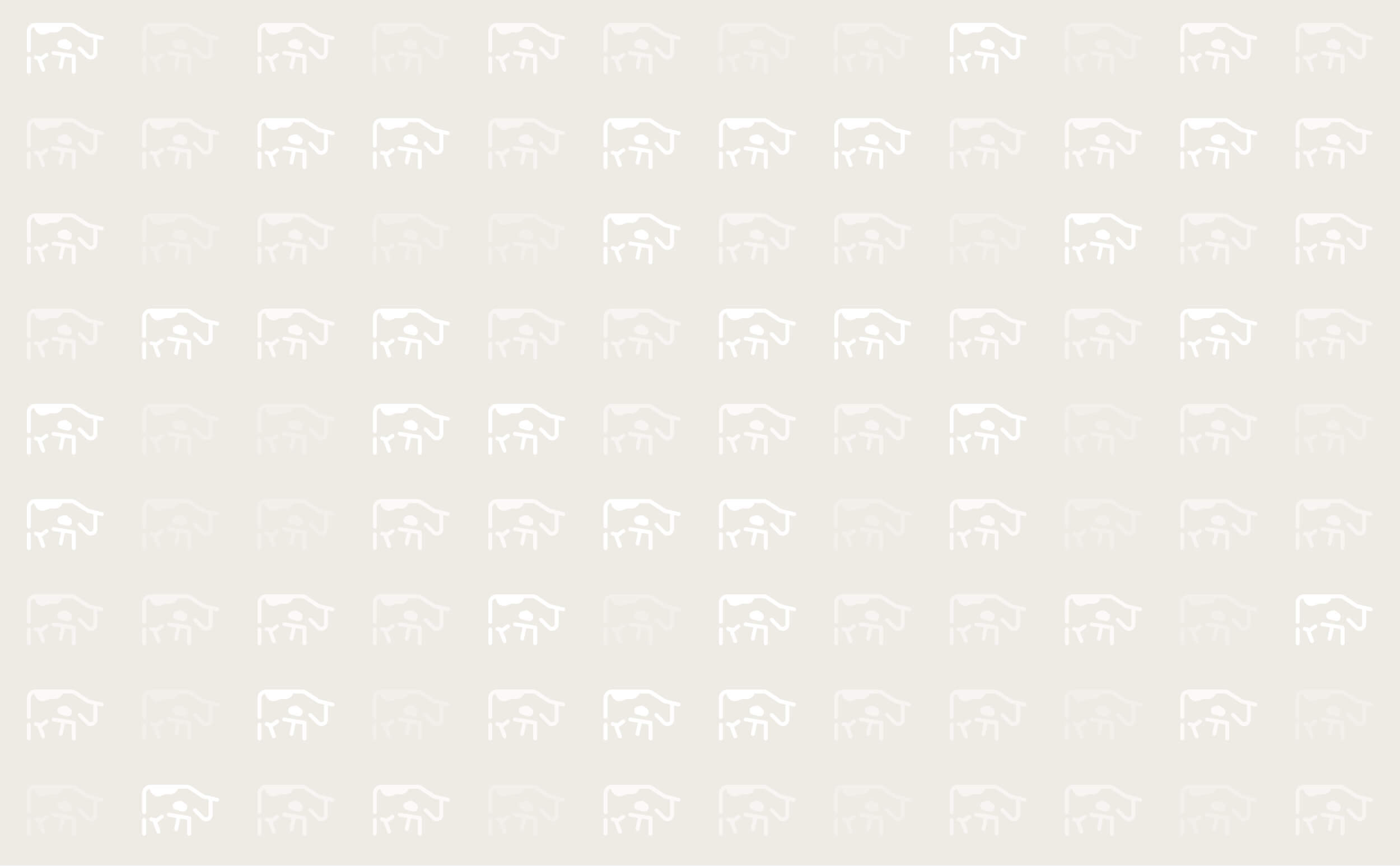



Belted Galloway
History
The unique appearance of Belted Galloway cattle inspires many questions about their origins. With black, red or dun color sandwiched about a white middle, they are familiarly known as 'Belties' among breeders of the animals. Though references to 'sheeted' cattle occur in literature and art as early as the 11th Century, the Belted Galloway's first recorded history indicates that they developed during the 16th Century in the former Galloway district of Scotland.
The Belted Galloway is essentially the same in origin and characteristics as the Galloway and only differ by the distininctve white belt that is thought to have been introduced by an infusion of Dutch Lakenvelder blood, probably in the seventeenth or eighteenth century, according to "History of the Belted Galloway Society Inc." The Herd Book of the Belted Galloway Society, Inc. (1951-1971) by A. Mims Wilkinson Jr.
Historians writings differ somewhat, but upon three points they generally agree regarding the origin of the Galloway/Belted Galloway. The breed is recognised to be a very ancient one, with obscure origins and its name derived from the word Gallovid or Gaul. The Gauls were the native inhabitants of the regality known as the Province of Galloway. The cattle of the region were said to be dark, smooth-polled, wavy-haired with undercoats like beavers fur and for centuries they went unnamed, referred to only as the black cattle of Galloway.

Peppercorn Xtra, photo courtesy of Peppercorn Belted Galloway Stud, www.belties.com.au |
From this coastal environment of winds and damp cold, combined with an undulating terrain of moors, granitic hills, heathery mountain ranges and fertile glens emerged the Galloway breed of cattle.
Though much has been written of the history of British cattle since the middle of the 18th century, the period immediately before that is almost without a record. Historian Hector Boece (1570), writing about the Galloway, says, "In this region ar mony fair ky and oxin of qubilk the flesh is right delicius and tender." Ortelius, the historian writing in 1573, says, "In Carrick (then part of Galloway) are oxen of large size, whose flesh is tender, sweet and juicy."
The Galloway breed of cattle became important during the Scoto-Saxon period, and the breeders of Galloway enjoyed the export of cheese and hides. Later the cattle were sold in considerable numbers to English farmers who sent them to Smithfield market after a fattening period on English grass.
It is said that the Galloway breed was never crossed with the other breeds. It is not known where the polled character was acquired by the Galloway breed because in its beginning many of the cattle were horned. However, many writers during the last part of the 1700's and early 1800's mentioned polled Galloway cattle, and the breeders decided they liked the polled characteristic and started selecting their cattle for the character. Most of the early cattle in the Galloway district were black, but red, brown, brindles, and cattle with white markings were not uncommon.
In 1851, a fire at the Highland Agricultural Museum at Edinburgh destroyed all the historical records and pedigrees of the Galloway collected prior to that time. Eleven years later (1862), a Polled Herd Book was published and it included the Galloway, Aberdeen, and Angus breeds. In 1878 the Galloway Cattle Society of Great Britain initiated its own volume of pedigrees. The first exportation of Galloways to North America came in 1853 to the Graham brothers of Toronto, Canada. Michigan State College, Lansing, imported the first Galloways to America in 1866. The American Galloway Breeders' Association organized in 1882 and Volume I of the North American Galloway Herd, published in 1883, listed American and Canadian Galloways.
Characteristics
The Belted Galloway is a very distinctive breed with its characteristic white belt which encircles the body, the rest of the body being black, dun or red in colour. The distinctive white belt found in Belted Galloways often varies somewhat in width and regularity but usually covers most of the body from the shoulders to the hooks.

The white contrast to the black coat, which may have a brownish tinge in the summer, sets the breed apart with its striking colour pattern.
They are naturally polled hill cattle are eminently suited for converting rough grazing into lean meat. Their double coat of long hair, to shed the rain, and soft undercoat, for warmth, eliminates the need for expensive housing.
The cows are long living (17-20 years), regular breeders noted for the amount of rich milk they produce, therefore rearing a good calf. They can be used to breed a good Blue Grey by putting them to a Whitebred Shorthorn. These Blue Greys and the pure bred cows cross well with Continental sires, such as Charolais, Simmental, Limousin and Salers.
It is claimed that the Belted Galloways are larger, milk heavier, and grow more rapidly than the parental breed.
A mature Belted Galloway Bull can weigh between 815 and 955 kilograms although some are smaller and others larger. A cow ranges from 400 to 600 kilograms, new born heifers weigh, on average around 30 kilograms and a bull calf can be 35 kilograms and sometimes more. "Beltie" calves weaned at 205 days, were about one half their mother's weight.
The Beltie as a beef animal produces exceptionally lean and flavorful meat, with carcass dressed weights well in excess of 60 percent of live weight.
These calves, having hybrid vigor, grow rapidly and produce the quality of beef without excess fat similar to purebred Belties.
Their most important trait, the economical production of beef under range conditions, stems from the fact that Galloways have been bred from their origin for beef production.
Statistics
The "Beltie" Breed is naturally polled and when crossed with another breed it will prevent the growth of horns in virtually all cases.
Belted Galloways are known for their ease of calving producing a live calf every year. Some Belted Galloways have had two separate calves in one year.
“Belties” are able to adapt to a variety of climatic conditions. They have good foraging abilities, ensuring that they thrive where other breeds fail. The coat is shed in hot weather, thus making the “Beltie” a highly adaptable and versatile breed for a variety of climatic conditions.
The breed was evolved in a harsh environment, resulting in high disease resistance and the ability to survive in the toughest of conditions.
Belted Galloway breeders find that their cattle are more resistant to pink eye, insects and foot problems than many other breeds. Congenital problems such as dwarfism are unknown to Belted and other Galloways.
Belties do not develop much fat under their hides; instead they have a double coat of hair consisting of a dense, soft, short undercoat and a long, shaggy overcoat, which is usually cast in hot weather. This double coat provides excellent protection in cold, wet, windy weather. In contrast, most other British beef breeds put on a thicker layer of uneconomical fat under their hides to provide the necessary insulation for protection against severe weather conditions.
Comparative
Growth
Tests have shown that the Galloway requires the least amount of feed per kilogram of weight gain making the cattle efficient converters.
Belted Galloways consume more varieties of flora than any other breed on tests conducted in Germany.
Hardiness
The Belted Galloway's heavy, double hair coat means that heat loss is reduced, winter feed costs are significantly less and rain hardly penetrates in cold, wet weather. The Belted Galloway cow has about 4000 hairs to the square inch making the coat resistant to severe cold.
Meat
Belted Galloway Beef has been shown in a research study conducted at the University of Guelph - to have a total fat content of about 2% an extremely low percentage. The same study showed that the Belted Galloway Beef tested only contained about 1% saturated fat. In addition it showed that Belted Galloway beef had the same fat content as chicken and fish so fits in well with a healthy diet. Belted Galloway beef is exceptionally tender, full of flavour and juicy and were the winners of the 2003 Sydney Royal Show "Beef Taste Test".
Data collected in the U.S. has shown that the beef dresses out at 60 - 62% of live weight making it a very profitable breed.
The GC & BMA 2008 Annual provides more research and current marketing objectives, a very interesting read.
Distribution
The Belted Galloway is popular in a number of countries ranging from Britain and Ireland to Australia, America, Canada and Switzerland.
References (the above information was cited from the following sites)


